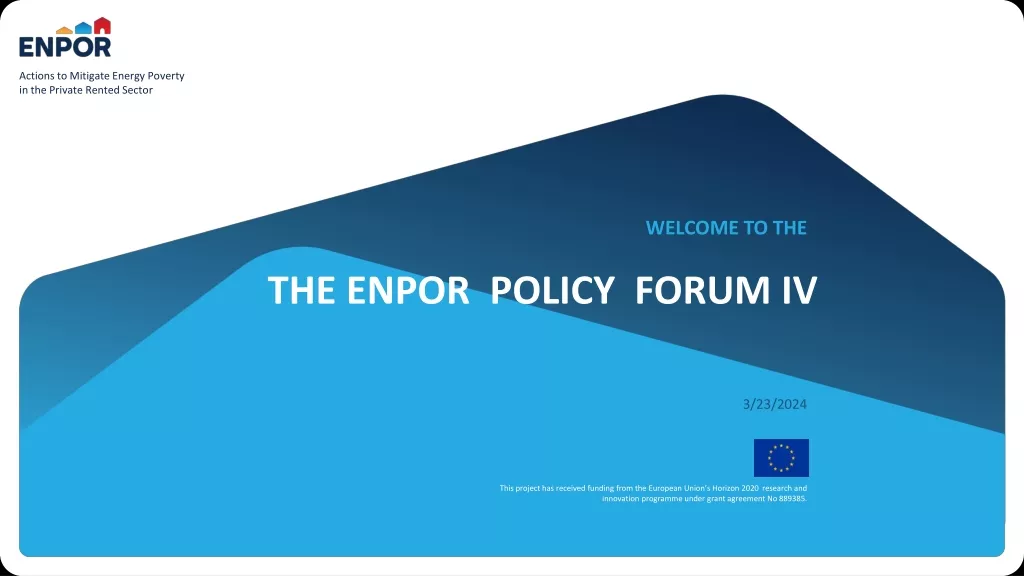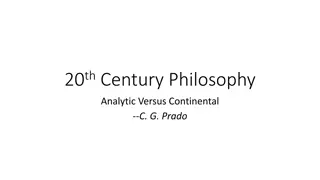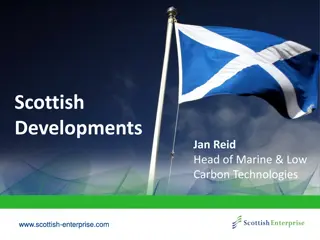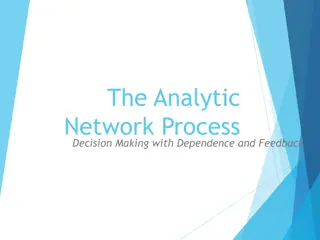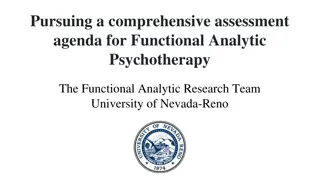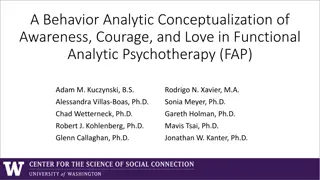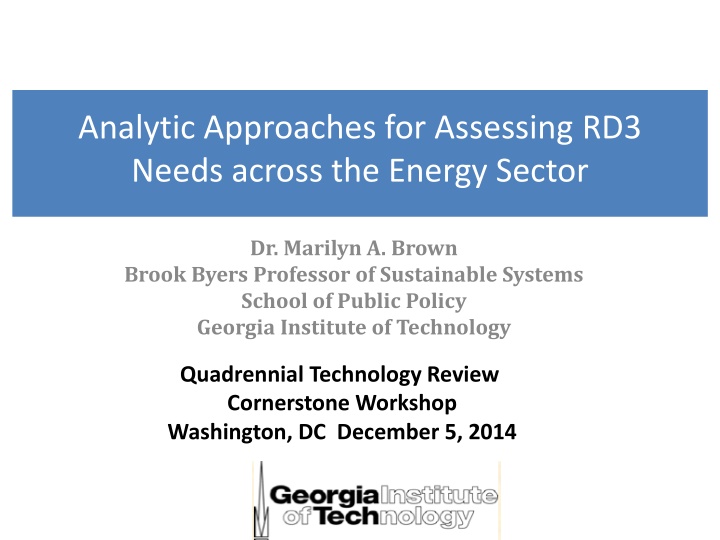
Analytic Approaches for Assessing RD3 Needs in Energy Sector
This insightful content explores various analytic approaches for assessing RD3 needs in the energy sector, presented by Dr. Marilyn A. Brown. The methods discussed include scenario analysis, expert elicitation, games and prediction markets, technology roadmapping, and more. These approaches delve into questions about technology impacts, system resilience, policy synergies, and future technology outcomes. Learn how these methods add value and contribute to enhancing decision-making processes in the energy industry.
Download Presentation

Please find below an Image/Link to download the presentation.
The content on the website is provided AS IS for your information and personal use only. It may not be sold, licensed, or shared on other websites without obtaining consent from the author. If you encounter any issues during the download, it is possible that the publisher has removed the file from their server.
You are allowed to download the files provided on this website for personal or commercial use, subject to the condition that they are used lawfully. All files are the property of their respective owners.
The content on the website is provided AS IS for your information and personal use only. It may not be sold, licensed, or shared on other websites without obtaining consent from the author.
E N D
Presentation Transcript
Analytic Approaches for Assessing RD3 Needs across the Energy Sector Dr. Marilyn A. Brown Brook Byers Professor of Sustainable Systems School of Public Policy Georgia Institute of Technology Quadrennial Technology Review Cornerstone Workshop Washington, DC December 5, 2014
Some Types of Analytic Approaches Types and questions: Scenario analysis: How do technology breakthroughs impact systems? Are systems resilient to disturbances? How do path dependencies & lock-in constrain options? Do policy impacts have synergies? Expert elicitation: Which technologies & policies? Games and prediction markets: Any new market trends? Technology roadmapping: What gaps need to be filled? Technology learning: When will technologies be ready? LCA and holistic ROI approaches: Any impacts overlooked? Chaos-based methods: How will actors respond? All of these methods can add value.
Scenario Analysis Typically uses equilibrium forecasts that reflect BAU vs. alternative economic, technology or policy forecasts. By modeling disturbances, we can see how resilient energy systems are, when the assumptions that underlie their planning suddenly no longer hold. in million tonnes CO2 Emissions GDP in 2020: $16,753 $16,758 $16,681 $16,662 (in $2005 B) (Brown, et al., 2001; Smith and Brown, 2014)
Expert Elicitation: Delphi Method & Analytic Network Process Solicit opinions of experts on a given topic Ask experts for arguments supporting opinion Summarize and distribute results to experts solicited Offer opportunity for experts to change opinion based on other experts input Iterate until results stabilize or consensus is reached Relies on principles of collective intelligence: Scanning Analysis Expert Survey Results Sources: http://www.techcastglobal.com/methodology Davoudpour et al. 2012
Games and Prediction Markets Screenshot from World Without Oil, an Alternate Reality Game based around alternative fuel choices Crowdsourcing assessment Alternate reality games ask volunteers to make technology choices in games representing future scenarios Prediction markets ask volunteers to place a monetary bet on specific future technology outcomes Source: National Academies of Science (2009)
Technology Roadmapping Multi-step, multi- method process to understand innovation pathways Develop data on Current state of technology R&D activities and key actors Commercialization activities SWOT analysis Gaps Select promising innovation pathways Example: Nanobiosensor Technologies Nanostructures Functions Biosensors Applications Source: Robinson et al. (2013)
Technology Learning and Maturity Analyzing rates of change in technology Diffusion (Bass/Gomperz curves) Cost declines (learning curves) Performance (Moore s law) Extrapolates these trends into the future Can signal when technologies might switch Cost and Penetration of A-Type LED Lights LED Lighting Cost ($/Kilolumen) Installed (Millions) Cumulative LED Lights Source: DOE, 2013
Life Cycle Analysis and Holistic Return on Investment Can incorporate externalities and nonrevenue returns: Environmental damages & job creation Exposure to price risk & regulation Can incorporate scenario analysis to understand risks to investment Can also compare to investments in other assets System boundaries can be expansive: +Battery End-of-Life Sources: Balachandra 2001; Lee, Thomas and Brown (2013)
Chaos-based Methods Agent Based Modeling Multiple autonomous agents interact based on internal rules Complex behaviors from simple individual rules Uses Technology adoption and penetration(Source: Epstein, et al., 2011) Market behaviors(Source: Sichao, et al. 2010) Artificial Neural Networks Machine learning method to discern patterns from data System of interconnected, adaptive neurons that approach the non- linearity of inputs Uses Short-term load forecasting (Source: Drezga and Rahman, 1998) Renewable generation forecasting (Source: Siminov, et al. 2012) Chaos-based methods (and other approaches) need stronger behavioral energy research.
Bibliography Balachandra, P.; Shekar, G.L. (2001) Energy technology portfolio analysis: An example of lighting for residential sector. Energy Conversion and Management, 42, 813-832 Brown, Marilyn A.; Mark D. Levine; Walter Short; Jonathan G. Koomey, 2001. Scenarios for a Clean Energy Future, Energy Policy, 2001, 29 (14): 1179-1196. Davoudpour, H.; Rezaee, S.; Ashrafi, M. (2012) Developing a framework for renewable technology portfolio selection. Renewable and Sustainable Energy Reviews, 16, 4291-4297 DOE. 2013. Revolution Now: The Future Arrives for Four Clean Energy Technologies Drezga, I; Rahman, S (1998) Input variable selection for ANN-based short-term load forecasting. IEEE Transactions on Power Systems Eppstein, M; et. al. (2011) An agent-based model to study market penetration of plug-in hybrid electric vehicles. Energy Policy.
Bibliography Lee, Dong-Yeon, Valerie M. Thomas, and Marilyn A. Brown. 2013. Electric Urban Delivery Trucks: Energy Use, Greenhouse Gas Emissions, and Cost-Effectiveness, Environmental Science and Technology, 47(14) 8022-2030. National Academies of Science, USA. (2009) Persistent Forecasting of Disruptive Technologies. Robinson, D.K.R.; Huang, L.; Guo, Y.; Porter, A.L. (2013) Forecasting Innovation Pathways (FIP) for new and emerging science and technologies. Technological Forecasting and Social Change, 80, 267-285 Sichao, K; Yamamoto, H; Yamaji, K (2010) Evaluation of CO2 free electricity trading market in Japan by multi-agent simulations. Energy Policy Simonov, M; et. al. (2012) Artificial Intelligence Forecast of PV Plant Production for Integration in Smart Energy Systems. IREE Smith, Alexander and Marilyn A. Brown. 2014. "Policy Considerations for Adapting Power Systems to Climate Change" The Electricity Journal, November, http://dx.doi.org/10.1016/j.tej.2014.10.00 TechCast Methodology. Accessed 11/25/2014 from http://www.techcastglobal.com/methodology 11
For More Information For More Information Dr. Marilyn A. Brown Brook Byers Professor of Sustainable Systems School of Public Policy Georgia Institute of Technology Marilyn.Brown@pubpolicy.gatech.edu Climate and Energy Policy Lab: http://www.cepl.gatech.edu 404-385-0303 Thanks to Alex Smith and Ben Staver, Graduate Research Assistants at Georgia Tech, for assistance with these slides: asmith313@gatech.edu bstaver@gatech.edu


